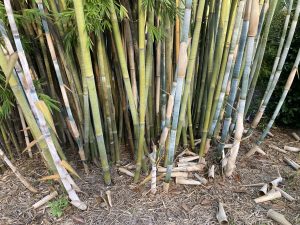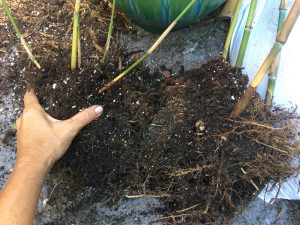In Florida, we have temperate to tropical climates that allow us to grow many species of bamboo. There are 1,400 of bamboo species in 115 genera worldwide. We also have a Florida native bamboo species, called switchcane (Arundinaria gigantea) which naturally grow along the rivers throughout Florida.
Clumping Vs Running Bamboo
Will the bamboo will take over the yard? Running bamboo spreads rapidly by underground runners and can be invasive. Running bamboo is not recommended for planting in Florida in home landscapes, some running bamboo are listed as high risk of invasion. Clumping bamboo will grow and produce new shoots but won’t travel far.
Types of Bamboo: Choosing a Clumping Bamboo Variety

Green Bamboo
The most popular bamboo in Florida for residential properties is ‘Graceful’ (Bambusa textilis gracilis) because it has a relatively short height to 25’ and grows upright with a dark green color. Another favorite is the giant timber bamboo (Bambusa oldhamii), which has the largest culms (stems) to 3 – 4”. Other popular varieties that are commercially available from local bamboo nurseries include ‘Fernleaf’ (Bambusa multiplex), ‘Seabreeze’ (Bambusa malingensis), and Buddha Belly (Bambusa vulgaris ‘Wawin’). Green bamboos grow easily and are somewhat cold hardy.
Black Bamboo
Black bamboos have a striking look but are less popular because they are more sensitive to cold and grow slower (making them more expensive). Black bamboos that grow well in Central or South Florida include Timor Black (Bambusa lako), Java Black (Gigantocloa atroviolacea) and the Black Asper (Dendrocalamus asper ‘Bering Hitam’), which is the largest of the black bamboos and can grow in USDA zone 9b or 10.
Blue Bamboo
Blue bamboos are called so because of the white powder on the young canes, which give them a pretty blueish color. Popular varieties include Tropical Blue (Bambusa chungii) and Angel Mist (Dendrocalamus minor amoenus).

Bamboo Uses
In the landscape, bamboo makes a great privacy barrier, it’s also used as a wind break and can reduce unpleasant noises with the soothing sound of its rustling leaves. It can be used as a specimen plant, living fence, or hedge if pruned. Bamboo is available in a variety of sizes, colors and textures for that tropical look. Some have edible shoots and the leaves can be used to make bamboo tea.
Bamboo Propagation
Bamboo can be propagated by division of the roots, stem cuttings or air layering. Propagation success varies by bamboo species and age of material used. Learn more about bamboo propagation.

Bamboo Maintenance
Bamboo can grow up to 70’ tall depending on the species. In all cases, it is good to remove any dead stems and cut them to ground level. Depending on your goal, you may want to top the bamboo and cut it to a certain height or hedge the bamboo to consistently trim it to the same height or shape. Bamboo likes regular watering and mulch. It’s also a great self-mulcher, dropping many leaves you can leave in place. Apply a slow-release fertilizer, low in phosphorus with near equal parts of nitrogen and potassium such as a 18-6-12 twice per year.
Removing Bamboo
Once established, bamboo can be difficult to remove or eradicate. Since it is basically a large grass, it doesn’t mind mowing. The first step is to cut the clump down, a Sawzall works good for this. To mechanically remove the bamboo, use a backhoe, a stump grinder, or dig it up. Glyphosate and imazapyr are both herbicides that can be used to kill bamboo. Imazapyr has residual soil activity so do not use if you have edibles in your landscape. See our publication on Bamboo Control.
Learn more:
UF/IFAS Gardening Solutions on Clumping Bamboo
EDIS publication on Bamboo Control
Follow Us!
We have several ways to connect. Join our UF/IFAS Extension Hillsborough County
Facebook, YouTube, Instagram, Eventbrite, Blogs, and Website
If you have any questions, please contact UF/IFAS Extension Hillsborough County at 813-744-5519 or email hillsmg@mail.ufl.edu.
The University of Florida is an Equal Opportunity Institution.
 6
6
